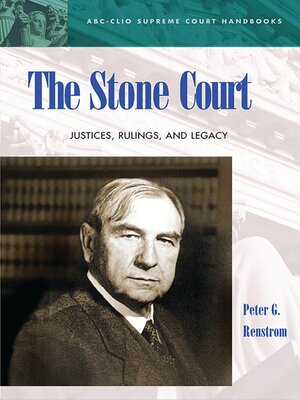The Stone Court
ebook ∣ Justices, Rulings, and Legacy · ABC-CLIO Supreme Court Handbooks
By Peter G. Renstrom

Sign up to save your library
With an OverDrive account, you can save your favorite libraries for at-a-glance information about availability. Find out more about OverDrive accounts.
Find this title in Libby, the library reading app by OverDrive.



Search for a digital library with this title
Title found at these libraries:
| Library Name | Distance |
|---|---|
| Loading... |
A comprehensive examination of the rulings, key figures, and legal legacy of the Stone Court.
When President Franklin Roosevelt got the chance to appoint seven Supreme Court justices within five years, he created a bench packed with liberals and elevated justice Harlan Fiske Stone to lead them. Roosevelt Democrats expected great things from the Stone Court. But for the most part, they were disappointed.
The Stone Court significantly expanded executive authority. It also supported the rights of racial minorities, laying the foundation for subsequent rulings on desegregation and discrimination. But whatever gains it made in advancing individual rights were overshadowed by its decisions regarding the evacuation of Japanese Americans. Although the Stone Court itself did not profoundly affect individual rights jurisprudence, it became the bridge between the pre-1937 constitutional interpretation and the "new constitutionalism" that came after.
When President Franklin Roosevelt got the chance to appoint seven Supreme Court justices within five years, he created a bench packed with liberals and elevated justice Harlan Fiske Stone to lead them. Roosevelt Democrats expected great things from the Stone Court. But for the most part, they were disappointed.
The Stone Court significantly expanded executive authority. It also supported the rights of racial minorities, laying the foundation for subsequent rulings on desegregation and discrimination. But whatever gains it made in advancing individual rights were overshadowed by its decisions regarding the evacuation of Japanese Americans. Although the Stone Court itself did not profoundly affect individual rights jurisprudence, it became the bridge between the pre-1937 constitutional interpretation and the "new constitutionalism" that came after.







